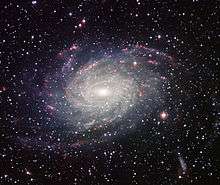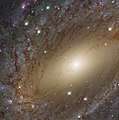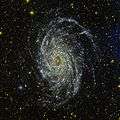NGC 6744
NGC 6744 (also known as Caldwell 101) is an intermediate spiral galaxy about 30 million light-years away[2] in the constellation Pavo. It is considered as a Milky Way mimic in our immediate vicinity, displaying flocculent (fluffy) arms and an elongated core. It also has at least one distorted companion galaxy (NGC 6744A) superficially similar to one of the Magellanic Clouds.[3] It was discovered from Parramatta in Australia by Scottish astronomer James Dunlop on 30 June 1826.[4]
| NGC 6744 | |
|---|---|
 Wide Field Imager view of a Milky Way look-alike NGC 6744. Credit: ESO | |
| Observation data (J2000 epoch) | |
| Constellation | Pavo |
| Right ascension | 19h 09m 46.1s[1] |
| Declination | −63° 51′ 27″[1] |
| Redshift | 0.002805[1] |
| Helio radial velocity | 841 ± 2 km/s[1] |
| Distance | 31 ± 5.2 Mly (9.5 ± 1.6 Mpc)[2] |
| Apparent magnitude (V) | 9.14[1] |
| Characteristics | |
| Type | SAB(r)bc[1] II |
| Apparent size (V) | 20′.0 × 12′.9[1] |
| Other designations | |
| Caldwell 101, PGC 62836 | |
NGC 6744 lies within the Virgo Supercluster.[5][6]
Gallery
References
- "NASA/IPAC Extragalactic Database". Results for NGC 6744. Retrieved 2006-08-31.
- "Distance Results for NGC 6744". NASA/IPAC Extragalactic Database. Retrieved 2010-06-19.
- "NASA/IPAC Extragalactic Database". Results for NGC 6744A. Retrieved 2010-06-19.
- Seligman, Courtney. "NGC Objects: NGC 6700 - 6749". cseligman.com. Retrieved 14 February 2019.
- P. Fouque; E. Gourgoulhon; P. Chamaraux; G. Paturel (1992). "Groups of galaxies within 80 Mpc. II - The catalogue of groups and group members". Astronomy and Astrophysics Supplement. 93: 211–233. Bibcode:1992A&AS...93..211F.
- "Nearby Groups of Galaxies". ned.ipac.caltech.edu. Retrieved 2018-05-04.
- "The Milky Way's big sister". www.spacetelescope.org. Retrieved 24 July 2018.
- "Hubble shows the local Universe in ultraviolet". www.spacetelescope.org. Retrieved 18 May 2018.
External links
| Wikimedia Commons has media related to NGC 6744. |
- NGC 6744 on WikiSky: DSS2, SDSS, GALEX, IRAS, Hydrogen α, X-Ray, Astrophoto, Sky Map, Articles and images
- NGC 6744, a Milky Way-like spiral galaxy
- NGC 6744 (Pav)
- June 4, 2010 – A Sibling of the Milky Way (Wise image of NGC 6744)
- A spiral galaxy that resembles our Milky Way (1 June 2011)
- Merrifield, Michael. "NGC 6744 The Milky Way's Twin". Sixty Symbols. Brady Haran for the University of Nottingham.
- NASA Astronomy Picture of the Day: NGC 6744 Close Up (May 31, 2018)
This article is issued from Wikipedia. The text is licensed under Creative Commons - Attribution - Sharealike. Additional terms may apply for the media files.




